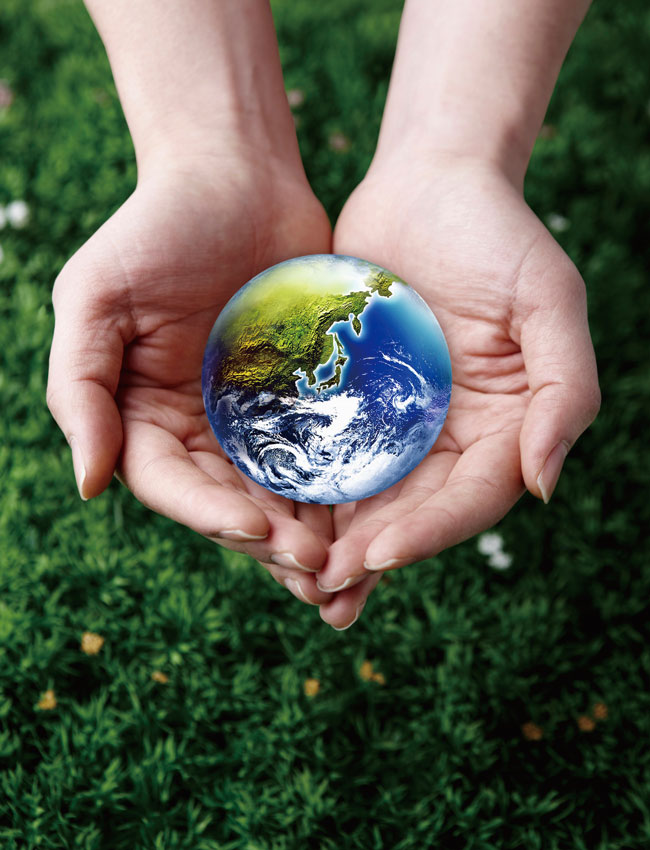To Have a Greener Spring 让春天更“绿”一些
By Vicco Wu
The Ministry of Environmental Protection (MEP) played a leading role at the first press conference of the State Council Information Office at the beginning of the Year of the Horse, where, after making a summary of the environmental progress for 2013, the MEP proposed “three battles” for 2014 and expressed intention to launch new policies related to air, water and soil pollution respectively.
It’s reported that global environmental problems are mainly seen in India, Iran, Mongolia, Brazil and China. In India, fast population growth and excessive discharge of sewage water have caused serious water pollution. In Iran and Mongolia, Ore mining has led to environmental pollution. In Brazil, timber mining has reduced the area of forests. Compared with these countries, China has the most serious air pollution.
Today, the smog in China has attracted global attention. In 2013, the State Council introduced the Atmospheric Pollution Prevention Action Plan (“Ten Rules for Atmospheric Pollution Prevention”) to control air pollution by region, stage and differentiated methods. The Plan requires that PM2.5 should be controlled in key areas such as Beijing, Tianjin, Hebei Province, Yangtze River Delta and Pearl River Delta, and PM10 should be controlled in other regions. The amount of PM2.5 shall be reduced by over 25% in Beijing, Tianjin and Hebei Province, by 20% in the Yangtze River Delta and by 15% in the Pearl River Delta, while the amount of PM10 should be reduced by over 10% in other regions.
After releasing the plan, the MEP has conducted a lot of follow-up work. For example, the MEP has made detailed requirements for Beijing, Tianjin, Hebei Province and six surrounding provinces (districts, cities) that 13 million tons of coal must be reduced in Beijing, 10 million tons in Tianjin, 40 million tons in Hebei Province and 20 million tons in Shandong, etc. Moreover, the MEP, together with relevant ministries, has divided 80 tasks set out in the Ten Rules for Atmospheric Pollution Prevention among 34 central and national departments, determined each roadmap and timetable and signed objective responsibility agreements with 31 provinces (districts, cities), which have been disclosed to the public.
The MEP has launched a monthly program to monitor the law enforcement in key areas since last October, where inspections and secret investigations are used, with focus on the latter. Even pilotless aircrafts were used in a large-scale monitoring program in last November. Now, 15 provinces (districts, cities) have developed local implementation plans to implement the Ten Rules for Atmospheric Pollution Prevention. In recently-held local Two Sessions, the governors, mayors, and chairmen of 28 provinces, cities and autonomous regions made environmental arrangements at great length in work reports, especially air pollution control work.
Meanwhile, officials with the MEP pointed out that water and soil pollution is also every severe. To solve water pollution, the MEP is developing the Water Pollution Prevention Action Plan, the core of which is to improve water quality, with focus on two aspects: strong water pollution control in heavily-polluted areas and strong protection of rivers and lakes with better water quality to avoid “pollution first and treatment second”. Furthermore, regarding soil pollution control, the MEP is developing a Soil Environmental Protection and Pollution Control Action Plan, similar to the Ten Rules for Atmospheric Pollution Prevention.
To meet the public’s right to know about the environment and prevent any disputes and group events resulting from thereof, the MEP has considered information disclosure as a crucial part in environmental protection and taken measures such as the release of environmental impact assessment reports and report forms to strengthen environmental supervision and urge local governments to solve the problem.
The four elements of “earth, air, water, fire” in the West and five elements of “gold, wood, water, fire, earth” in China are all directed to basic elements of life, so environmental concerns are also a manifestation of respect for life. In 1962, American biologist Rachel Carson published a book titled as Silent Spring, which explained the environmental pollution and damage caused by the pesticide DDT.
Alarmed by the book, the U.S. Government initiated an investigation on highly toxic pesticides, established the U.S. Environmental Protection Agency in 1970 and all states passed laws to prohibit the production and use of highly toxic pesticides. The book has been considered as the start of environmental ecology in the 20th century.
Environmental protection is more about prevention than control. Rational use of natural resources, energy conservation, biodiversity protection and prevention of environmental pollution and damage shall be remembered at all times. Thus, development of environmental consciousness is also crucial. I believe that with joint efforts, we will have a greener spring.
Behavior Initiative for Environmental Protection
Starting from small things beside us. A small favor from each of us contributes to something big.
1)Water conservation: Turning off the faucet after use, repeated use of water and protection of water sources.
2)Electricity conservation: Turning off the light after use, reducing the use of electric appliances and air conditioners and supporting green lighting.
3)Prudent use of cleaners: Using eco-friendly cleaners such as phosphate-free detergents to reduce water pollution.
4)Green travel: Traveling by bike, maximum use of public transportation vehicles such as buses and subways, use of unleaded petrol and reduction of emissions.
5)Reduced use of paper: Reducing deforestation to lighten the burden on the earth.
6)No waste of food: Supporting the “Clean Your Plate” campaign.
7)Purchase of eco-friendly products: Less use of disposable Products by bringing your own shopping bags and choosing green packages. Use of CFC-free products to protect the ozone layer, purchase of eco-friendly batteries to prevent mercury cadmium pollution and maximum use of green, pollution-free products.
8)Promoting waste sorting and recovery: Sorting and recovery of waste plastics, batteries and paper and bio-waste.
9)Recycling of renewable resources: Waste utilization to support environmental protection; exchange and donation of unused items to avoid waste.
10)Refused consumption of wild plants and animals: Treating life kindly and protecting the food chain to coexist with all things.
马年伊始,国务院新闻办的第一场新闻发布会,环境保护部成了主角。在总结介绍了2013年环保工作进展之后,环保部
提出了2014年的“三大战役”,大气、水和土壤污染治理将分别推出新政。
据悉,全球环境污染问题目前主要集中在印度、伊朗、蒙古、巴西和中国。印度的问题是人口剧增,生活污水排放超量
造成水污染严重;伊朗和蒙古都是矿石开采引发的环境污染;巴西则是木材滥砍滥伐使得森林面积减少,而与这些国家
相比,中国的大气问题最为严重。
如今,中国的雾霾已经引起了全球的关注。2013年国务院颁布了《大气污染防治行动计划》(“大气十条”),力图分
区、分阶段、差别化地对大气污染进行治理:京津冀、长三角、珠三角等重点区域控制PM2.5,其他地区则只要求控制
PM10。京津冀PM2.5要求削减25%以上,长三角要求削减20%,珠三角要求削减15%,对于其他地区则要求PM10削减10%以
上。
文件发布后,环保部做了大量的后续工作。如对京津冀及周边六省(区、市)提出细化要求:北京煤炭要削减1300万吨
,天津煤炭净削减1000万吨,河北削减4000万吨,山东削减2000万吨等;会同有关部门,把“大气十条”的80项任务分
解到中央和国家机关的34个部门,明确了各自的路线图和时间表;还与全国31个省(区、市)签订了目标责任书,并向
社会公开。
从去年10月份开始,环保部每个月都组织一次重点区域的执法监察活动,采取巡查、暗查的方式,以暗查为主,去年11
月份组织的一次大规模监察活动还动用了无人机。目前全国已经有25个省(区、市)为落实“大气十条”制定了本地的
实施方案。近期各地召开的“两会”中,已经有28个省、市、自治区的省长、市长、主席在工作报告中大篇幅地安排部
署环保工作,尤其是大气污染防治工作。
同时,环保部的官员指出,其实水环境、土壤污染的治理,形势也非常严峻。为解决水污染问题,环保部正在编制《水
污染防治行动计划》,该文件的核心是改善水环境质量,重点是抓两头,一是坚决治理污染严重的地方,二是坚决保护
水质较好的河湖,不能先污染再治理。此外,在土壤污染治理方面,环保部也在编制一个类似于“大气十条”的《土壤
环境保护和污染治理行动计划》。
为了满足公众的环境知情权,防止因此引发的纠纷及群体性事件,环保部已把信息公开看作环保工作的重要组成部分,
通过发布环境影响评价报告书、报告表等措施,加大环境监管力度,督促各地解决问题。
西方的四元素“土、气、水、火”,中国的五行“金、木、水、火、土”,指向的都是关乎生命的基本要素,因此关注
环保也是尊重生命的一种表现。1962年,美国生物学家蕾切尔·卡逊出版了《寂静的春天》一书,阐释了农药杀虫剂
DDT对环境的污染和破坏作用,由于该书的警示,美国政府开始对剧毒杀虫剂进行调查,并于1970年成立了环境保护局
,各州也相继通过禁止生产和使用剧毒杀虫剂的法律。该书被视为20世纪环境生态学的起点。
环境保护不能一味事后治理,更应该事先防护——合理地利用自然资源,节省能源,保护生物多样性,防止环境的污染
和破坏,这些都是我们应该随时谨记的。由此可见,环保观念的养生也至关重要。相信只要大家一起努力,春天一定会
更“绿”一些的!
环境保护,行为倡议
从小事做起,从身边做起,举手之劳,点点滴滴,汇成江河!
1)节约用水——随手关龙头,一水多用,监护水源。
2)节约用电——随手关灯,少用电器,减用空调,支持绿色照明。
3)慎用清洁剂——选无磷等环保清洁剂,减少水污染。
4)绿色出行——骑自行车出行,尽量多地使用公交、地铁等公共交通工具,使用无铅汽油,减少尾气排放。
5)降低用纸——减少森林砍伐,减轻地球负担。
6)不浪费粮食——支持“光盘”行动。
7)购买环保产品——少用一次性制品,自备购物袋,选绿色包装。用无氟制品,保护臭氧层;买环保电池,防止汞镉
污染;尽量选择绿色无公害产品。
8)推动垃圾分类回收——分类回收废塑料、废电池、废纸和生物垃圾。
9)循环再利用可再生资源——废物利用,支持环保;交流捐赠闲置物品,避免浪费。
10)拒绝野生动植物消费——善待生命,保护生物链,与万物共存。




You must be logged in to post a comment Login